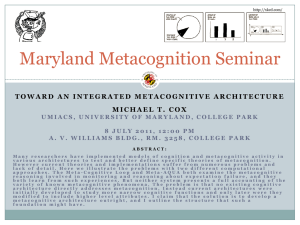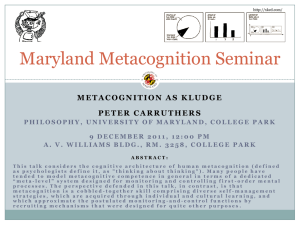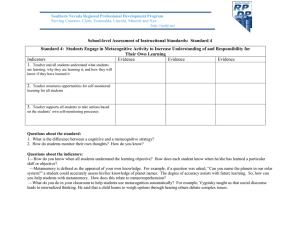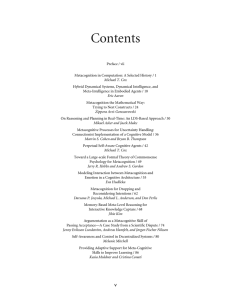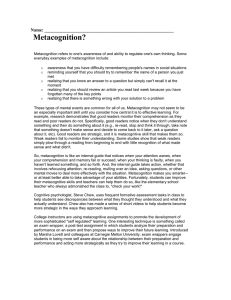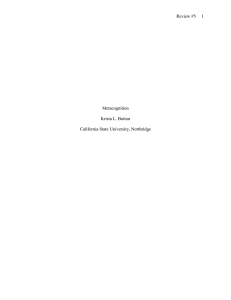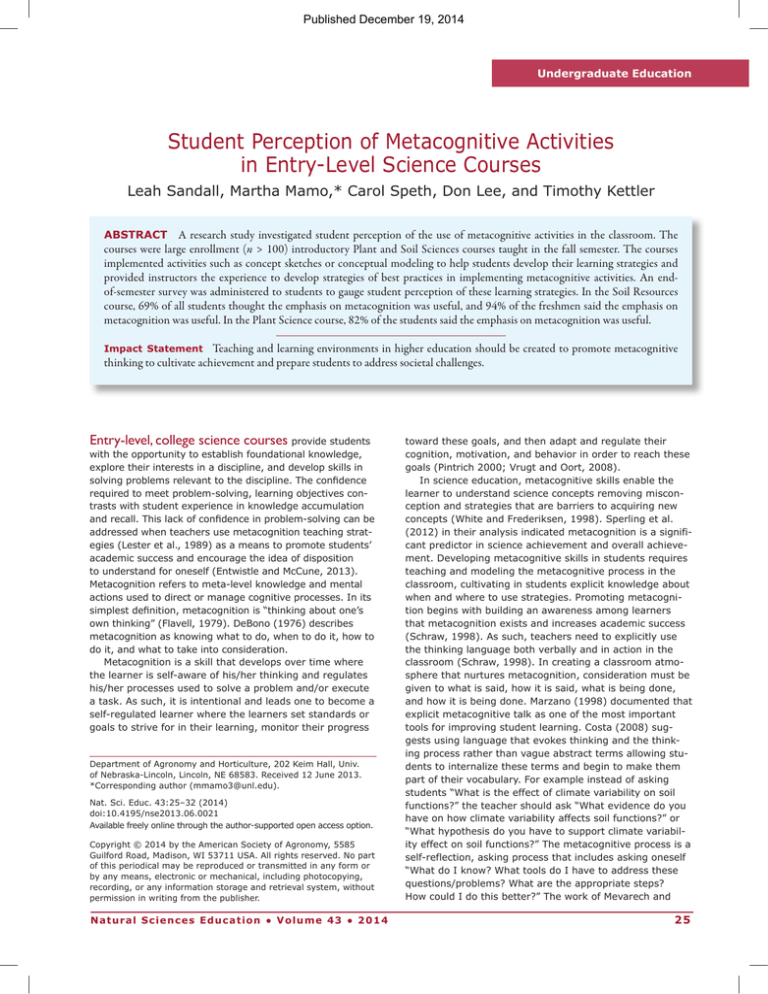
Published December 19, 2014
Undergraduate Education
Student Perception of Metacognitive Activities
in Entry-Level Science Courses
Leah Sandall, Martha Mamo,* Carol Speth, Don Lee, and Timothy Kettler
ABSTRACT A research study investigated student perception of the use of metacognitive activities in the classroom. The
courses were large enrollment (n > 100) introductory Plant and Soil Sciences courses taught in the fall semester. The courses
implemented activities such as concept sketches or conceptual modeling to help students develop their learning strategies and
provided instructors the experience to develop strategies of best practices in implementing metacognitive activities. An endof-semester survey was administered to students to gauge student perception of these learning strategies. In the Soil Resources
course, 69% of all students thought the emphasis on metacognition was useful, and 94% of the freshmen said the emphasis on
metacognition was useful. In the Plant Science course, 82% of the students said the emphasis on metacognition was useful.
Impact Statement Teaching and learning environments in higher education should be created to promote metacognitive
thinking to cultivate achievement and prepare students to address societal challenges.
Entry-level, college science courses provide students
with the opportunity to establish foundational knowledge,
explore their interests in a discipline, and develop skills in
solving problems relevant to the discipline. The confidence
required to meet problem-solving, learning objectives contrasts with student experience in knowledge accumulation
and recall. This lack of confidence in problem-solving can be
addressed when teachers use metacognition teaching strategies (Lester et al., 1989) as a means to promote students’
academic success and encourage the idea of disposition
to understand for oneself (Entwistle and McCune, 2013).
Metacognition refers to meta-level knowledge and mental
actions used to direct or manage cognitive processes. In its
simplest definition, metacognition is “thinking about one’s
own thinking” (Flavell, 1979). DeBono (1976) describes
metacognition as knowing what to do, when to do it, how to
do it, and what to take into consideration.
Metacognition is a skill that develops over time where
the learner is self-aware of his/her thinking and regulates
his/her processes used to solve a problem and/or execute
a task. As such, it is intentional and leads one to become a
self-regulated learner where the learners set standards or
goals to strive for in their learning, monitor their progress
Department of Agronomy and Horticulture, 202 Keim Hall, Univ.
of Nebraska-Lincoln, Lincoln, NE 68583. Received 12 June 2013.
*Corresponding author (mmamo3@unl.edu).
Nat. Sci. Educ. 43:25–32 (2014)
doi:10.4195/nse2013.06.0021
Available freely online through the author-supported open access option.
Copyright © 2014 by the American Society of Agronomy, 5585
Guilford Road, Madison, WI 53711 USA. All rights reserved. No part
of this periodical may be reproduced or transmitted in any form or
by any means, electronic or mechanical, including photocopying,
recording, or any information storage and retrieval system, without
permission in writing from the publisher.
Na t ura l Sc i en ces E du ca ti on • V ol u me 4 3 • 2 0 1 4
toward these goals, and then adapt and regulate their
cognition, motivation, and behavior in order to reach these
goals (Pintrich 2000; Vrugt and Oort, 2008).
In science education, metacognitive skills enable the
learner to understand science concepts removing misconception and strategies that are barriers to acquiring new
concepts (White and Frederiksen, 1998). Sperling et al.
(2012) in their analysis indicated metacognition is a significant predictor in science achievement and overall achievement. Developing metacognitive skills in students requires
teaching and modeling the metacognitive process in the
classroom, cultivating in students explicit knowledge about
when and where to use strategies. Promoting metacognition begins with building an awareness among learners
that metacognition exists and increases academic success
(Schraw, 1998). As such, teachers need to explicitly use
the thinking language both verbally and in action in the
classroom (Schraw, 1998). In creating a classroom atmosphere that nurtures metacognition, consideration must be
given to what is said, how it is said, what is being done,
and how it is being done. Marzano (1998) documented that
explicit metacognitive talk as one of the most important
tools for improving student learning. Costa (2008) suggests using language that evokes thinking and the thinking process rather than vague abstract terms allowing students to internalize these terms and begin to make them
part of their vocabulary. For example instead of asking
students “What is the effect of climate variability on soil
functions?” the teacher should ask “What evidence do you
have on how climate variability affects soil functions?” or
“What hypothesis do you have to support climate variability effect on soil functions?” The metacognitive process is a
self-reflection, asking process that includes asking oneself
“What do I know? What tools do I have to address these
questions/problems? What are the appropriate steps?
How could I do this better?” The work of Mevarech and
25
Table 1. Metacognitive activities implemented in Soil Resources
and Plant Science in fall semester 2011 at the University of
Nebraska-Lincoln.
Soil
resources
Plant
science
Develop course goals at the beginning
of the semester and assess whether
you have achieved them at the end.
X
X
Complete a knowledge survey at the
beginning and end of each unit.
X
Complete an exam wrapper and
evaluate what went well and what did
not and how you plan to prepare for the
next exam.
X
X
Develop conceptual maps and sketches
for ideas/concepts and to connect
ideas.
X
X
Activity
Fig. 1. Example of student work group set-up in Soil Resources
and Plant Science fall semester 2011 at the University of
Nebraska-Lincoln.
Kramarski (1997) on metacognitive instruction emphasizes
reflective discourse to teach mathematical knowledge and
reasoning.
This metacognitive instruction known as IMPROVE
entails:
1. Introducing the new material;
2. Metacognitive questioning (what is the problem,
connecting problem to past experience, identifying
appropriate strategies, evaluating appropriateness of
the solution);
3. Practicing;
4. Reviewing;
5. Obtaining mastery on higher and lower cognitive
processes;
6. Verification; and
7. Enrichment and remediation.
In an effort to create a “thinking classroom” and promote
efficiency in learning for academic success, a pilot project
was initiated to evaluate the efficacy of course activities in
helping students develop self-awareness in learning. The
overall goal was to explicitly integrate metacognitive practices in both lower- and upper-level courses. The courses in
this pilot project were large enrollment (n > 100) entry level
Plant and Soil Sciences courses taught in the fall semester.
It is postulated that providing these experiences in gateway
courses will help cultivate metacognition in students and
promote efficiency in learning. At the same time, teachers
have the opportunity to develop the experience and techniques to explicitly integrate metacognitive practices.
MATERIALS AND METHODS
Course and Student Population
Descriptions
Soil Resources (AGRO/SOIL/HORT 153), a 4-credit-hour
introductory course, is required for many students majoring in the College of Agricultural Sciences and Natural
Resources (CASNR) at the University of Nebraska-Lincoln
(UNL). Students attend a lecture period (50 minutes) once
per week and two laboratory-recitation periods (110 minutes each) each week. There were a total of 7 lab sections,
with approximately 20 to 24 students in each section during the fall of 2011.
26
Use models (for the gene expression
process) to illustrate processes/
concepts.
X
Write reflection on topics and/or units
recently completed.
X
Generate questions when reviewing
notes.
X
Discuss responses to oral questions
with group.
X
X
Discuss responses to activities with
group.
X
X
Solve problems with group
X
X
Explain to instructors how answers
were derived.
X
X
Introductory Plant Science (AGRO/HORT 131), a
3-credit-hour course, is required for many students with
majors in the Agronomy and Horticulture Department at
UNL. The course is taught so that students attend two
lectures (50 minutes each) and one recitation period (110
minutes) per week. In the semester that the pilot study
was conducted there were a total of four recitation sections with approximately 25 students in each. In the fall
of 2011, this course was also taught online in which all
course requirements were completed over the Internet and as a hybrid section (lectures and material delivered online with a once per week, face-to-face recitation
meeting).
Both courses run for a full semester (16 weeks). The labrecitation period consists of short, up-front instruction (10–
20 minutes) during each meeting in addition to some interactive elements (questions, student-centered reviews, inclass quizzes, hands-on activities). Students work in groups
of approximately three to four students to complete activities and problems (Fig. 1). Metacognition was explained
and instruction given at the beginning of the semester. An
instructor was available to answer questions and help guide
learning throughout each lab-recitation period.
Activities Enforcing Metacognition
Both Soil Resources and Plant Sciences implemented
metacognitive activities in the classroom in similar ways.
Metacognitive activities can be categorized into three
areas: planning, monitoring, and evaluation (Schraw et
al., 2006). Activities such as developing goals and planning exam strategies fall under the metacognitive area
of planning. Monitoring activities included items like
developing concept sketches and maps, using models to
explain course topics, and generating questions as content is reviewed. Concept sketches engage students in
N a tur a l S c i e nc e s E d uc a ti on • Vol um e 43 • 20 1 4
Fig. 2a. Concept sketch on soil erosion and processes from a case study developed by students in Soil Resources fall semester 2011 at the
University of Nebraska-Lincoln.
Based on the Holmes Lake (Lower Platte South Basin) case study:
A. Develop a concept sketch for this case addressing how soil erosion contributed to Holmes lake impairment. Consider
the following in your overall sketch:
1. Type of erosion and process within the Holmes Lake watershed
2. Role of land use and land use change
3. Role of Antelope creek banks
4. Impact on lake functions (aquatic life, recreation etc…)
B. Develop recommendations for the Antelope Creek watershed to reduce future damage to the Lake (What can builders
do? What can home owners do?, etc…). Present your evidence for each recommendation of how it would efficiently
work to reduce sedimentation/pollution of the lake and resource loss (soil loss by erosion) within the watershed.
Fig. 2b. Example concept sketch activity on erosion in Soil Resources at the University of Nebraska-Lincoln (example student sketch for this
activity is presented in Fig. 2a).
the learning process, develop critical thinking skills, teach
communication skills, and at the same time help identify
student misconceptions (Johnson and Reynolds, 2005).
The evaluation area pertains to students’ reviewing goals
at the end of the semester or reviewing graded exams to
identify misconceptions, inaccuracies, and develop better
strategies for future exams. The goal of using these activities in the classroom was to provide opportunity for students to practice metacognitive skills while learning Soil
or Plant Sciences content. The two courses implemented
the metacognitive activities listed in Table 1 (examples of
activities in Fig. 2 and 3).
Na t ura l Sc i en ces E du ca ti on • V ol u me 4 3 • 2 0 1 4 27
Fig. 3. Concept map on photosynthesis, respiration, translocation, and transpiration developed by students in Plant Science fall semester
2011 at the University of Nebraska-Lincoln.
Description of the Evaluation
The survey administered asked students to respond to
questions assessing their perception of the metacognitive
activities and other teaching tools used in the classroom
on their overall learning in the course. The survey was
deployed using Survey Monkey, which allowed anonymous
electronic data collection (Table 2).
Data were collected at the end of the semester. The survey included demographic information on students’ year in
school and major and was administered with Institutional
Review Board Approval (IRB #200306328 EX) to ensure
student confidentiality. Completion of the survey indicated
that students were consenting to participate in the study. A
scale of 0 to 3 was used on questions where students were
asked to rank specific activities (Table 2). The survey given
was very similar for both Plant Science and Soil Resource
students but asked for specific feedback related to activities
conducted in each course. Students in both courses were
given extra credit points for participating in the survey.
RESULTS AND DISCUSSION
Academic Major Descriptions
In Soil Resources, 44% of students were in an agriculture-related major, whereas 19% were an environmentalrelated major. In Plant Science, almost 60% of students
28
were in an agricultural-related major and only 2.5% were
in an environmental area (Table 3).
An important question of interest was whether a majority of students in each class acknowledged that the emphasis on metacognition was useful. Another question was
how students of different class standing would view the
emphasis on metacognitive activities. Open-ended item
responses were included in the survey questionnaires.
In the Soil Resources course, 69% of all students
thought the emphasis on metacognition was useful, 19%
said it was not, and 12% were unsure. In Soil Resources,
94% of the freshmen said the emphasis on metacognition was useful. Seventy five percent, 68%, and 48% of
the sophomores, juniors, and seniors, respectively, found
the emphasis helpful. Here are two sample comments from
this course:
• The metacognition processes were helpful in outlining course objectives and staying focused on the end
result.
• If this was the first time I had come into contact with
these methods I would definitely have said yes but
I’ve had this all throughout high school. I can see how
they may be applicable to younger students or different
majors though.
In Plant Science, 82% of the students said the emphasis on metacognition was useful, 8% said it was not, and
N a tur a l S c i e nc e s E d uc a ti on • Vol um e 43 • 20 1 4
Table 2. Survey questions used in survey completed by students in Soil Resources and Plant Science in fall semester 2011 at the University
of Nebraska-Lincoln.
Survey questions
1
Do you think the emphasis on learning strategies and study skill in this course was valuable to you?
2
Please give an example of a learning strategy or study skill that worked for you in this course. Please be specific.
3
You were asked to participate in a number of activities to improve your learning strategies and study skills. Please evaluate them in
terms of their usefulness for you in this course.
(Various activities listed in survey for students to evaluate.)
4
Please evaluate each of the following strategies in terms of how often you used them.
(Various strategies listed in survey for students to evaluate.)
5
How useful were the following supporting resources?
(Various resources listed in survey for students to evaluate.)
6
Did the exams and graded assignments measure how much you really learned?
(Various graded items listed in survey for students to evaluate.)
7
Comments about any of the questions.
Table 3. Student majors and class standings in Soil Resources and Plant Science in the fall semester 2011 at the University of Nebraska-Lincoln.
Major
Soil resources
n = 95
Plant science
n = 138
—————————————— % ——————————————
Agricultural Science and Business
Agricultural Education and Journalism
Environmental Sciences and Natural Resources
39.3
57.1
4.8
2.5
16.7
2.6
Forensic Science
9.5
Horticulture
7.1
9.2
13.2
18.5
7.1
10.1
Landscape Design and Turf Management
Mechanized Systems Management
0
Class standing
Freshman (≤ 26 hours accrued)
18
52.9
Sophomore (27–52 credit hours accrued)
25
22.1
Junior (53–88 credit hours accrued)
30
15
Senior (≥ 89 credit hours accrued)
26
5.7
Graduate
0
2.9
Other
1
1.4
10% were unsure. Almost 84% of the freshman, 71% of the
sophomores, 86% of the juniors, and all of the seniors said
it was useful. Sample comments from this course were:
• I feel like these strategies and skills would have helped
me greatly in a class that I was not very interested
or involved in. But since I found this class to be very
interesting I was able to study and learn perfectly fine
the old fashion (sic) way.
• Yes and no. I felt I was still learning, and it was great to
pick up new strategies, but it seemed a bit overwhelming to me.
The evaluation included which strategies students valued most and least (Table 4). One series of questions
focused on learning strategies: “You were asked to participate in a number of activities to improve your learning
strategies and study skills. Please evaluate them in terms
of their usefulness for you in this course.” In the Soil
Resources course, students gave the highest mean rating to “Solve problems with your classmates,” followed by
“Explain to the instructor how you derived your answer.”
They gave their lowest ratings to “Develop course goals.”
In Plant Science, the highest mean rating went to “Using
models to explain processes/concepts,” followed by “Solve
problems as a group” and “Concept maps.” The lowest
ratings were for “Generate your own questions as you
review your notes.”
Students were asked to evaluate each of the following strategies in terms of how often they used them.
Students in the Soil Resources course gave the highest
Table 4. Highest and lowest ratings of activities by students in Soil
Resources and Plant Science fall semester 2011 at the University
of Nebraska-Lincoln.
Category
Highest rating
Lowest rating
Soil resources
Strategies
solve problems with
your classmates
develop course goals
How often
use pre-exam summary
as a learning tool
generate questions
Resources
manual, lab group,
hands-on
textbook
How useful
manual, lab group,
hands-on
textbook
Measures
lab quizzes, exam
project
Strategies
using models to
explain, solve problems
as a group
generate questions
How often
answer all questions in
problem set before quiz
generate questions
Resources
instructor communication, problems
online resources
How useful
answer all questions in
problem set before quiz
online resources
Measures
reading quizzes,
think-a-loud
experiment write-up
Plant sciences
Na t ura l Sc i en ces E du ca ti on • V ol u me 4 3 • 2 0 1 4 29
frequency rating to using the pre-examination reflection (Fig. 4) as a learning tool for each topic, followed
by reviewing their completed worksheets. They gave the
lowest frequency rating to generating questions from the
topic and trying to answer them. Students in Plant Science gave the highest frequency ratings to answering all
questions in their problem set before taking the quiz and
applying course content to a case study. They gave the
lowest frequency ratings to generating questions from the
topic and trying to answer them.
When students were asked how useful the following supporting resources were, those in the Soil Resources class
gave the highest rating to the course manual, then the lab
group and hands-on learning. They gave the lowest rating
to the textbook. In Plant Science, students gave the highest
ratings to instructor communication and working problems.
They gave the lowest ratings to online resources. However
it should be said that the online ebook was highly valued by
some students. Sample comments were:
• I liked the ebook quizzes because you got initial feedback and that helped me understand what I needed to
study more.
• The online ebook that went with each week. This
allowed us to read and see how the material was
applied to a real life situation, which is helpful as it
shows us how we may use it in our futures as well.
• The problem set and ebook was a great repetitive
learning strategy.
Students in each class were asked whether the exams
and graded assignments measured how much they really
learned. Soils students gave the highest rating to lab quizzes and exams. They gave lowest ratings to the group
project. Students in Plant Science gave their highest rating
to the quizzes and their lowest ratings to experiment writeups. In both courses the textbook (traditional or as the
online eBook), projects, and generating questions seemed
to be the least preferred learning activities. It is possible
that textbook-assigned reading can be objective based and
linked to specific activities. The experiments and project
write-ups as well as generating questions require higherorder thinking and self-reflection to interpret the data,
connect the data to concepts, and articulate explanations
in writing using the data as evidence.
The instructors began teaching with this emphasis on
metacognition so students would begin to think about
their own thinking. The best positive indication came from
responses to the open-ended questions, which indicated a
degree of success to explicitly integrate certain activities to
enhance questioning, monitoring, and evaluation of one’s
own thinking.
• I feel the test review/reflections were a valuable tool.
They allowed me to go back through the sections on
the test and gain more information about what was
going to be covered on the exam.
• Pre-flections for exams. It was a good way of forcing us
to study the correct materials.
• Filling out the Pre-Exam sheets really helped me to
understand the lessons. I liked having to make the
word webs because it cemented how concepts were
connected.
• I learned a lot of discipline throughout this course. It
wasn’t something that could be put off and I had to
discipline myself to get some studying done around the
rest of my schedule.
30
Soil Resources 153
Reflection on Unit and in Preparation for Exam
DUE ON DAY OF THE EXAM
Please address each of the four items separately.
Turn in a clean copy the day of the exam.
1. Develop a list of vocabulary words with your OWN
definition (suggested 5 vocabs. per topic).
2. What are the main ideas from each topic?
3. In your opinion, what essential knowledge and
skills have you taken from this unit?
4. Create a visual representation of the connection of
main ideas (see #2 above) learned thus far
(Hint: Think concept sketch and model format).
Checklist
• Re-review topics exercises.
• Find a study group and ask questions or explain to
each ideas and calculations.
• For problem solving questions, draw pictures to help
you understand what the problem is asking and
evaluate the given information within the problem,
and then seek appropriate solution.
• Rework the calculations and know when to use the
appropriate equation relationships. Understand
what story the calculations are telling you.
• Work the calculation problems backward to check
yourself.
• Use online quizzes as review tool.
• Use knowledge survey questions as study guide.
• Re-review assigned readings.
• Use past exam to prepare for exam.
• Attend review session if offered.
• Others…
Fig. 4. Example guidelines for developing post-lesson and preexamination reflection in Soil Resources fall semester 2011 at the
University of Nebraska-Lincoln.
• The metacognition processes were helpful in outlining
course objectives and staying focused on the end result.
• Turning in reviews of the chapters we went over before
each test helped me review the concepts and make sure I
understood them.
• I found the summary and reflections for each section to be
quite useful. By the time I was done completing them, I
was already pretty well prepared for the coming exam.
• I believe when actually taking the time to think about the
way your (sic) thinking, you learn more about how your
(sic) going to remember this and not just throw out an
answer. You try and think about all aspects of the topic,
and not just memorize a question.
• I believe the learning quizzes helped me after lectures
because they made me think about what I learned in the
lecture.
• Exam Reviews, Jeopardy Tests and Quizzes let me prepare
for the exam. They let me know the kind of questions I
have to be prepared for and offer a high quality feedback.
• I would review the Problem Set questions a lot because
they always seemed to help me better understand the
lesson.
N a tur a l S c i e nc e s E d uc a ti on • Vol um e 43 • 20 1 4
This study suggested that the metacognitive activities
were having a positive effect. However, there are a few
students who felt this was unnecessary or “busy work.”
See example comments below:
• I already study well and did not feel that being told how
to study a certain way was a good use of my time.
• I would have liked more time spent on the material, a
better manual, and more helpful teaching techniques,
rather then (sic) all of the busy work.
• There were way too many surveys, course wrap ups,
evaluations, etc. I realize it’s a freshman level course
but if I was looking for ways to improve my learning I
would take a psychology course. The best measure of
my learning was from the exams.
CONCLUSIONS AND IMPLICATIONS
Students reacted positively in terms of the usefulness
of many items. The highest perceived preference in Plant
Science was the models (Fig. 5), whereas it was group
problem solving for Soil Resources. Soil Resources students reported using the course manual, developing a
summary, and relating ideas frequently. Plant Science students reported using problem sets, applying concepts to a
case study, and relating ideas most often. Students in both
courses reported that generating questions and critiquing
ideas were not frequently used.
Instructors recognized the importance of being explicit
with discussion about metacognition in the classroom
so that students can begin making connections between
activities and learning. Students are novices in metacognitive skills and may resist such approaches during the
course. However, they may value these skills later as independent thinking is expected in other courses and careers.
Based on the findings from this pilot study, it seems that
a high percentage of students recognize the value of
actively engaging in metacognition. Instructors in both
courses are motivated to continue expanding these activities, given 82% of the Plant Science students and 69% of
the Soil Resources students responded that the metacognition emphasis was useful. Recognizing metacognition as
a valuable learning tool for both instructors and students
is a long process. Therefore, exposure to metacognitive
activities needs to be implemented throughout curriculum to maximize effectiveness for students, at the same
time, authentic activities that enhance metacognitive skills
require time to prepare, plan, and implement.
Instructor Reflections and Metacognition
Resources for the Classroom
Instructors for both courses observed students being
more engaged with the course content when metacognitive
activities were implemented. At times this translated into
more student questions or even students self-correcting
when completing the activities. With certain metacognitive activities, like the concept map/sketch and using models, students appeared to also be more engaged with their
peers in the class by posing questions to one another, creating more discussions, and demonstrating more depth of
content knowledge. Instructors for both courses also commented that it was necessary, at times, to revise metacognitive activities after the first use to better fit the needs
and the level of the students and course content. Occasionally, some students would choose to construct a reflective narrative about the content rather than construct
Fig. 5a. Photosynthesis model (hands-on activity) constructed by
students in Plant Science fall semester 2011 at the University of
Nebraska-Lincoln.
Photosynthesis Model Instructions:
Use the paper pieces to construct and show the process of both the light reaction and the dark reaction
in photosynthesis. You should be able to explain and
show the steps in each process to your instructor using
the model.
Fig. 5b. Photosynthesis model instructions students were given in
Plant Science fall semester 2011 at the University of NebraskaLincoln.
diagrams to show connection and relationships among
ideas. Some, if not all, often did not know how to begin
a concept map/sketch. For such reasons, instructors usually provided hints and examples to help students start the
activities (apprenticeship).
Often the most difficult aspect of implementing new
methods in the classroom is the limitation of time. The following is a list of ideas, tips, and resources based on trial
and error, as well as observation, to help guide development of metacognitive activities.
1. Teacher enthusiasm about metacognition in the classroom translates to student buy-in.
2. Modify or improve the way questions are asked in the
classroom and immerse classroom with explicit metacognitive talk.
3. Model metacognitive thinking and process in the
classroom. For example, the instructor constructs or
generates a concept map or sketch to help students
see how to organize ideas and explain knowledge.
4. Be willing to try an activity with the students and
have it not work as planned. This allows for revisions
tailored to a specific course.
5. Collaborate with colleagues. Sharing ideas and
resources creates synergy.
6. Use available resources, such as the ones from
the following website: http://serc.carleton.edu/
NAGTWorkshops/metacognition/index.html
7. Start small by implementing one type of activity in
your course, like the concept map or exam reflection/
wrapper.
Na t ura l Sc i en ces E du ca ti on • V ol u me 4 3 • 2 0 1 4 31
References
Costa, A.L. 2008. The thought-filled curriculum. Educ. Leadership
65(5):20–24.
DeBono, E. 1976. Teaching thinking. Temple Smith, London.
Entwistle, N., and V. McCune. 2013. The disposition to understand
for oneself at university: Integrating learning processes with
motivation and metacognition. Brit. J. Educ. Psychol. 83:267–
279. doi:10.1111/bjep.12010
Flavell, J.H. 1979. Metacognition and cognitive monitoring: A new
area of cognitive-developmental inquiry. Am. Psychol. 34:906–
911. doi:10.1037/0003-066X.34.10.906
Johnson, J.K., and S.J. Reynolds. 2005. Concept sketches: Using
student- and instructor-generated, annotated sketches for
learning, teaching, and assessment in geology courses. J.
Geosci. Educ. 53(1):85–95.
Lester, F.K., J. Garofalo, and D. Lambdin Kroll. 1989. Selfconfidence, interest, beliefs, and metacognition: Key influences on problem-solving behavior. In: D.B. McLeod and V.M.
Adams, editors, Affect and mathematical problem solving.
Springer-Verlag, New York. p. 75–88.
Marzano, R.J. 1998. A theory-based meta-analysis of research on
32
Mevarech, Z.R., and B. Kramarski. 1997. IMPROVE: A multidimensional method for teaching mathematics in heterogeneous classrooms. Am. Educ. Res. J. 34(2):365–395.
doi:10.3102/00028312034002365
Pintrich, P.R. 2000. Multiple goals, multiple pathways: The role of
goal orientation in learning and achievement. J. Educ. Psychol.
92:544–555. doi:10.1037/0022-0663.92.3.544
Schraw, G. 1998. Promoting general metacognitive awareness.
Instr. Sci. 26(1/2):113–125. doi:10.1023/A:1003044231033
Schraw, G., K.J. Crippen, and K. Hartley. 2006. Promoting selfregulation in science education: Metacognition as part of a
broader perspective on learning. Res. Sci. Educ. 36:111–139.
doi:10.1007/s11165-005-3917-8
Sperling, R.A., A.S. Richmond, C.M. Ramsay, and M. Klapp. 2012.
The measurement and predictive ability of metacognition in
middle school learners. J. Educ. Res. 105:1–7. doi:10.1080/00
220671.2010.514690
Vrugt, A., and F.J. Oort. 2008. Metacognition, achievement goals,
study strategies and academic achievement. Metacognition
Learn. 3:123–146. doi:10.1007/s11409-008-9022-4
White, B., and J. Frederiksen. 1998. Inquiry, modeling, and meta-
instruction. Mid-Continental Regional Educational Laboratory,
cognition: Making science accessible to all students. Cognition
Aurora, CO. p. 29–65.
Instruct. 16(1):3–118. doi:10.1207/s1532690xci1601_2
N a tur a l S c i e nc e s E d uc a ti on • Vol um e 43 • 20 1 4

